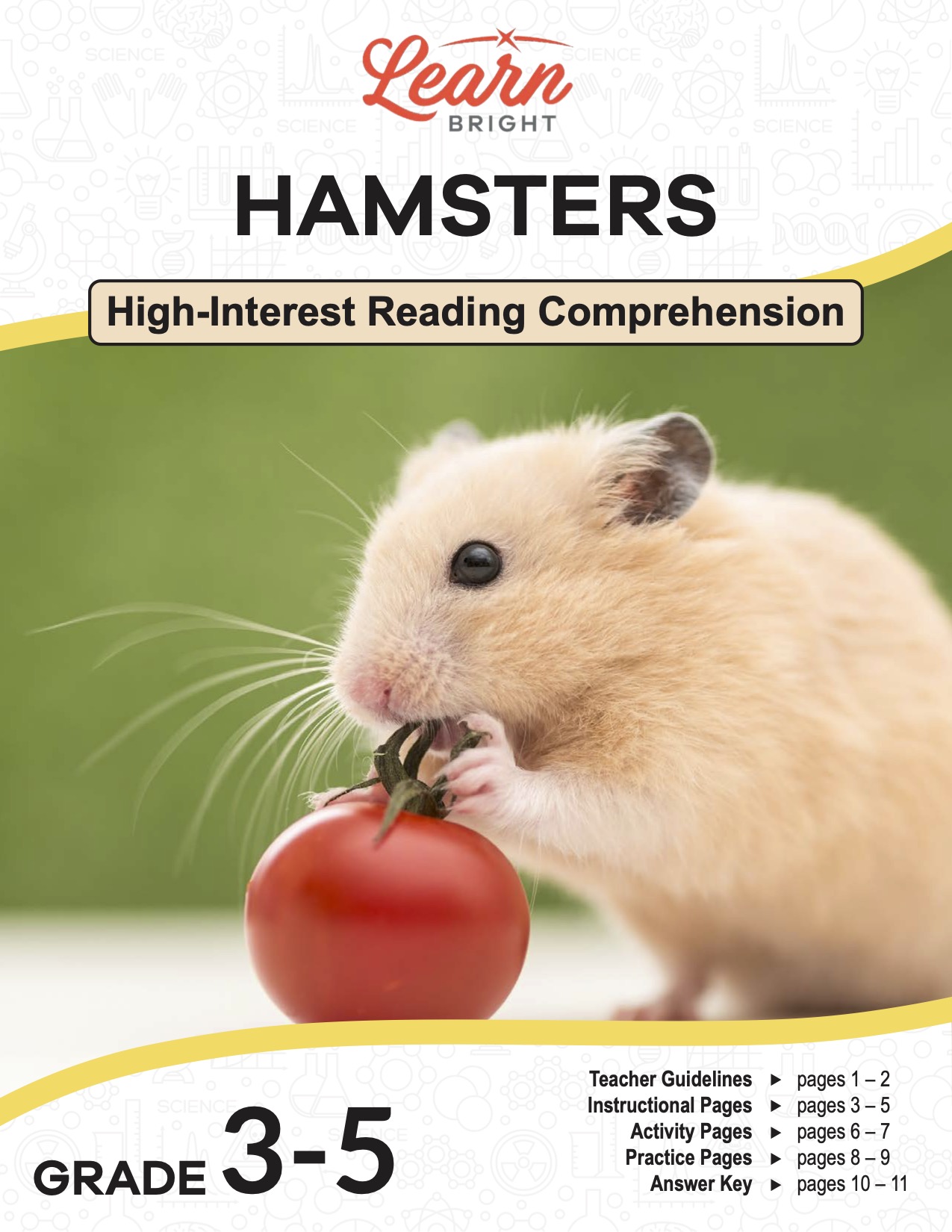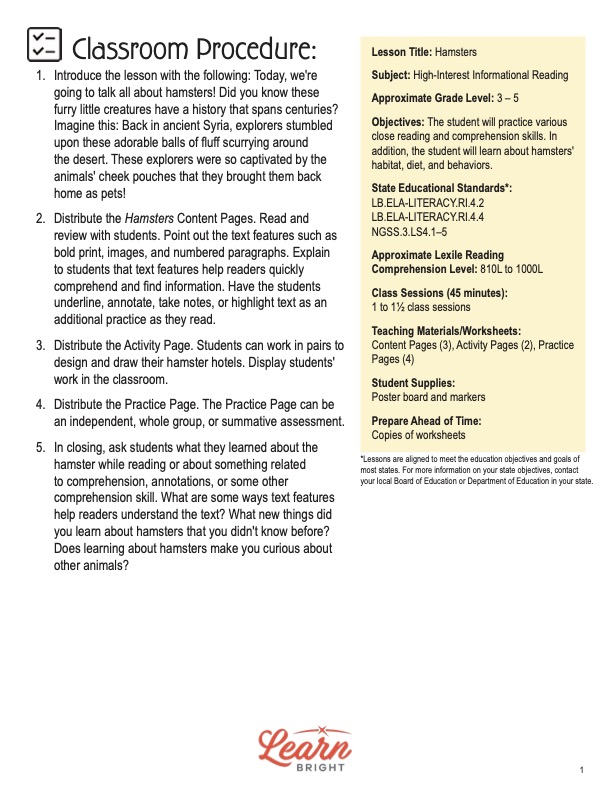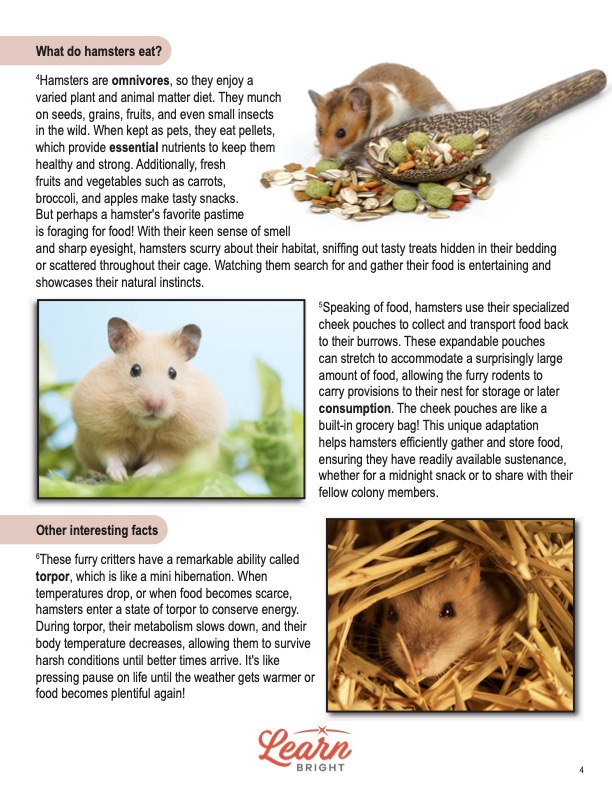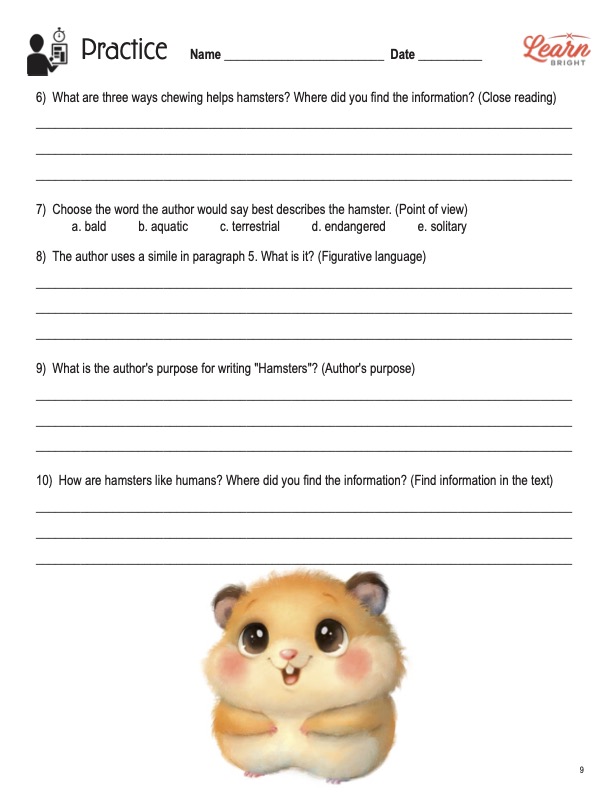Description
What our Hamsters lesson plan includes
Lesson Objectives and Overview: Hamsters is a high-interest reading comprehension lesson plan. As such, students will practice various close reading and comprehension skills. In addition, they will learn about the hamster’s habitat, diet, and behaviors. This lesson is for students in 3rd grade, 4th grade, and 5th grade.
Classroom Procedure
Every lesson plan provides you with a classroom procedure page that outlines a step-by-step guide to follow. You do not have to follow the guide exactly. The guide helps you organize the lesson and details when to hand out worksheets. It also lists information in the yellow box that you might find useful. You will find the lesson objectives, state standards, and number of class sessions the lesson should take to complete in this area. In addition, it describes the supplies you will need as well as what and how you need to prepare beforehand. You’ll need poster board and markers for the activity in this lesson.
Teacher Notes
The teacher notes page provides an extra paragraph of information to help guide the lesson. It explains that you can teach this lesson in a whole-class setting or as an independent, small-group activity. You can use the blank lines to write down any other ideas or thoughts you have about the topic as you prepare.
HAMSTERS LESSON PLAN CONTENT PAGES
What Are Hamsters?
The Hamsters lesson plan contains three content pages. To start off, it provides a small box with basic background information about hamsters. These cute critters are mammals that live in the wild in Europe and Western Asia. They are omnivores, so they munch on plants and animals. Their life span is generally between 1.5 and 3 years.
Hamsters are small mammals with round bodies that are covered in soft fur. They have short legs and small ears that wiggle when they’re excited. But what’s really special about hamsters is their cheek pouches. These pouches are tiny spaces in their cheeks where they can store food to munch on later. It’s like having a snack on the go!
In the wild, hamsters make their homes in underground burrows. These burrows have cozy rooms where the hamsters can sleep and nest. Hamsters often live in groups called colonies, sharing their tunnels and looking out for each other. They are nocturnal, which means they’re most active at night. So, while we’re getting ready for bed, they are just waking up and getting ready to explore!
When it comes to family, hamsters are great parents! Female hamsters, called sows, give birth to tiny babies called pups. They carefully nurse and protect the pups until the young hamsters are old enough to venture out independently. It’s impressive how hamster moms care for their young, grooming them and keeping them warm in their burrows. Like humans, hamsters value family and work together to ensure everyone is safe and sound.
What They Eat
Hamsters are omnivores, so they enjoy a varied plant and animal matter diet. They munch on seeds, grains, fruits, and even small insects in the wild. When kept as pets, they eat pellets, which provide essential nutrients to keep them healthy and strong. Additionally, fresh fruits and vegetables such as carrots, broccoli, and apples make tasty snacks. But perhaps a hamster’s favorite pastime is foraging for food! With their keen sense of smell and sharp eyesight, hamsters scurry about their habitat, sniffing out tasty treats hidden in their bedding or scattered throughout their cage. Watching them search for and gather their food is entertaining and showcases their natural instincts.
Speaking of food, hamsters use their specialized cheek pouches to collect and transport food back to their burrows. These expandable pouches can stretch to accommodate a surprisingly large amount of food, allowing the furry rodents to carry provisions to their nest for storage or later consumption. The cheek pouches are like a built-in grocery bag! This unique adaptation helps hamsters efficiently gather and store food, ensuring they have readily available sustenance, whether for a midnight snack or to share with their fellow colony members.
Other Interesting Facts
These furry critters have a remarkable ability called torpor, which is like a mini hibernation. When temperatures drop, or when food becomes scarce, hamsters enter a state of torpor to conserve energy. During torpor, their metabolism slows down, and their body temperature decreases, allowing them to survive harsh conditions until better times arrive. It’s like pressing pause on life until the weather gets warmer or food becomes plentiful again!
Like many rodents, hamsters’ teeth grow continuously throughout their lives. But don’t worry—hamsters have a clever solution to prevent overgrown teeth. They love to chew on wooden toys, cardboard tubes, and even hard food to wear down their teeth naturally. This constant gnawing keeps their teeth in tip-top shape, provides mental stimulation, and helps relieve stress.
If there was a competition for digging, hamsters would definitely take home the gold medal! Hamsters are experts at tunneling and burrowing. In fact, they can create an elaborate network of tunnels in their bedding or substrate in just one night. These tunnels provide them with shelter and protection and mimic their natural habitat in the wild.
Why Hamsters Are Important to the Environment
Hamsters may be small, but they play a significant role in their ecosystems! As seed-eating rodents, they help control plant populations by dispersing seeds through their droppings. This helps maintain the balance of plant species in their habitats. And, of course, they are part of the food chain, serving as prey for predators like owls, foxes, and snakes. By being a food source for these animals, they contribute to the biodiversity of their ecosystems.
While hamsters aren’t considered endangered, some species face threats due to habitat loss and changes in agricultural practices. As humans develop land for housing and farming, hamsters lose their natural habitats, making it harder for them to find food and shelter. Conservation efforts, such as creating protected areas and implementing sustainable farming practices, can help ensure that hamsters continue to thrive in the wild!
HAMSTERS LESSON PLAN WORKSHEETS
The Hamsters lesson plan includes two worksheets: an activity worksheet and a practice worksheet. Each one will help students solidify their grasp of the material they learned throughout the lesson. You can refer to the classroom procedure guidelines to know when to hand out each worksheet.
LUXURY HAMSTER HOTEL ACTIVITY WORKSHEET
For the activity, students will enjoy creating the perfect hotel for a hamster. They will refer to the elements on the first activity page to ensure their hotel meets the requirements. Then they will design it on the grid paper on the second worksheet page. Display students’ work when they have finished!
REVIEW PRACTICE WORKSHEET
The practice worksheet requires students to answer a series of 10 questions. These questions all relate to the content pages, so students will need to refer to them often for the answers. In addition, each question provides which reading tool the question corresponds to, such as text feature, vocabulary, or comprehension.
Worksheet Answer Keys
At the end of the lesson plan document is an answer key for the practice worksheet. The correct answers are all in red to make it easier for you to compare them with students’ responses. If you choose to administer the lesson pages to your students via PDF, you will need to save a new file that omits these pages. Otherwise, you can simply print out the applicable pages and keep these as reference for yourself when grading assignments.










